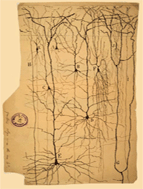| Overview |
How is information from the world represented by neural activity? The nature of the neural code remains a topic of intense debate. Topics include tuning curves and receptive fields, the rate coding and temporal coding hypotheses, oscillations and synchrony, sparseness and population codes, information theory, and the neural basis of decision making.
|
|
| Topics |
Students can choose almost any relevant journal article for presentation. There are a lot of cutting-edge papers that
have come out recently; I will make a list of these at the beginning of the term.
Here are some classic papers that we are likely to cover:
DeCharms & Zador - Neural Representation and the Cortical Code.
Overview of neural coding and representation, specifically dealing with cortex and the relationship to perception and behavior.
Konig et al - Integrator or Coincidence Detector? The Role of the Cortical Neuron Revisited.
A theoretical discussion of how the biophysical properties of cortical neurons may or may not affect how they encode information into action potentials. Depending on the integration window, neurons could either act as temporal integrators or as coincidence detectors on their synaptic inputs.
Wehr & Laurent - Neural Coding of Odors by Oscillatory Sequences of Firing.
A study of neural coding in the grasshopper olfactory system, where neurons synchronize to a global oscillation in a stimulus-dependent fashion.
Mehta, Lee & Wilson - Role of Experience and Oscillations in Transforming a Rate Code into a Temporal Code.
This paper looks at a form of temporal coding called phase precession, and relates it to firing rates at different time scales, in the context of sequence learning.
Harris et al - Spike Train Dynamics Predicts Theta-Related Phase Precession in Hippocampal Pyramidal Cells.
Like Mehta et al., this paper demonstrates that phase precession doesn’t necessarily encode spatial information. They suggest that phase precession is essentially a consequence of the biophysics of dendritic integration.
Bialek et al - Reading a Neural Code.
The seminal reverse correlation paper, which shows how one can decode the information transmitted by single spikes.
Pouget & Dayan - Inference and Computation with Population Codes.
What kinds of computation is population coding good for? Does distributed activity just represent the stimulus? This paper reviews the idea that a distributed population code uses neuronal variability to represent uncertainty about the stimulus, and that the computations done on this representation can best be understood as Bayesian inference.
Hanloser, Kozhevnikov, & Fee - An Ultra-Sparse Code Underlies the Generation of Neural Sequences in a Songbird
Recent data from the zebrafinch song system, showing that pre-motor neurons use a temporally sparse and precise code.
Olshausen & Field - Sparse Coding of Sensory Inputs
A review of sparse coding in sensory systems. What does sparseness mean, what is it good for, and what’s the evidence for it?
Platt & Glimcher - Neural Correlates of Decision Variables in Parietal Cortex
If sensory neurons represent sensory stimuli, and motor neurons represent motor output, what about the neurons in the middle? What do they represent, and with what code? This paper proposes that brain areas in between the sensory and motor sides are involved in decisions, and that in addition to sensory and motor information, their activity represents decision-theoretic variables such as expected gain (how much reward you can expect for a given sensory-motor decision).
|
|



